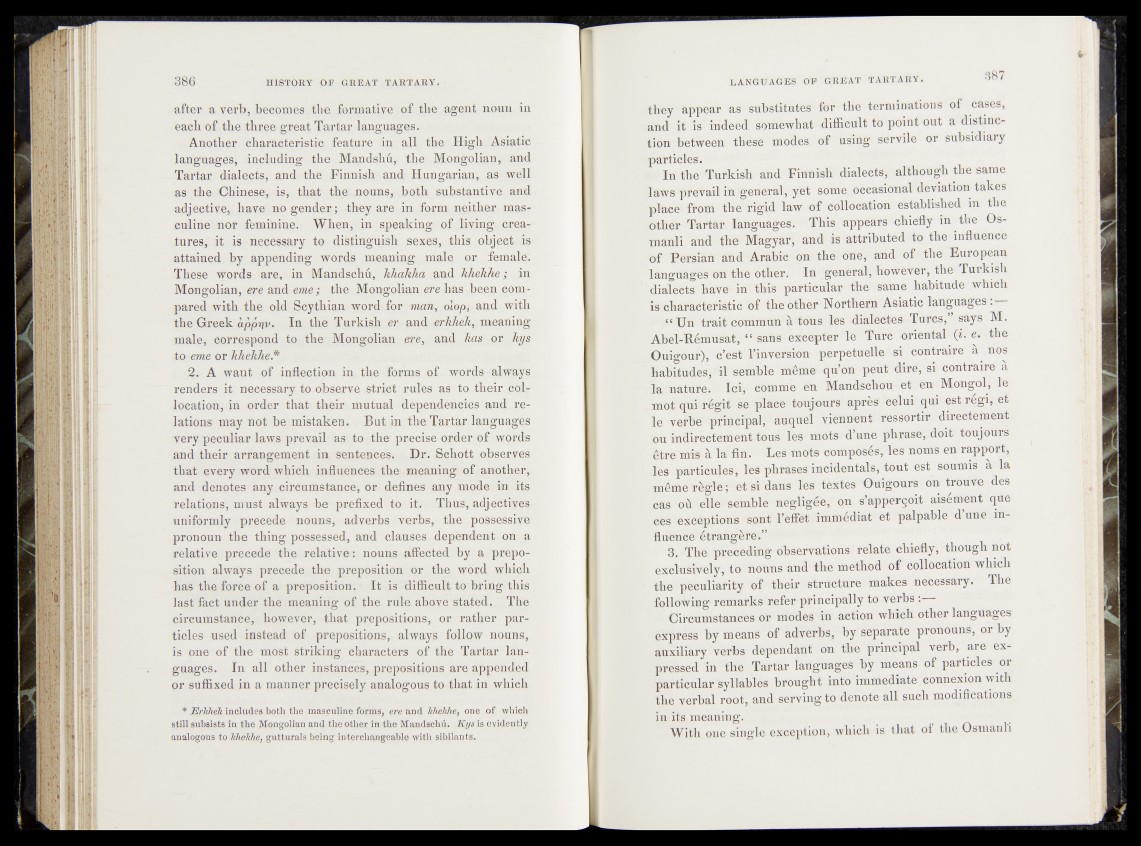
after a verb, becomes , the formative of the agent noun io
each of the three great, Tartar 1 anguages.
Another characteristic feature, "in; all the High Asiatic
languages, including the Mandshd, the Mongolian, and
Tartar dialects, and the Finnish and Hungarian, as well
as the Chinese, is, that the nouns, both substantive and
adjective, have no gender; -they are in form neither mas?-
culine nor feminine. When, in speaking of living creatures,
it is necessary to distinguish sexes, this object- is1
attained by appending words meaning male or female
These words are, in Mandsehu, khakha and khehhe; in
Mongolian, ere and eme; the Mongolian ere -has been, compared
with the. old Scythian word for man, olop; and with
the Greek appr\v- In the Turkish er and erkhek, meaning
.male, correspond to the Mongolian ere, and has kys
to eme or khekhe.*
3, A want of inflection in the forms of?-words always
renders it necessary to observe, strict rules as to .their, collocation,
in order that their mutual dependencies and, relations
may not be mistaken. But in the Tartar languages
very peculiar laws prevail as to the precise order iof words
and their arrangement in sentences. Dr. Schott observes
that every word which influences the meaning* of another,
and denotes any circumstance, or defines any mode in its
relations, must always be prefixed to its. Thus, adjectives
uniformly precede nouns, adverbs verbs, the possessive-
pronoun the thing possessed, and clauses dependent . on a
relative precede the relative: nouns affected by a preposition
always precede the preposition or the word which
has the force of a preposition. It is difficult to'bring this
last fact under the.meaning of the rule above stated, The
circumstance, however, that prepositions, or rather particles
used instead of prepositions, always follow nouns,
is one of the most striking characters of the Tartar languages.
In alT other instances, prepositions are appended
or suffixed in a manner precisely analogous to that in which
* ErJthek includes both the masculine forms, ere and khehhe, one of which
still subsists in the Mongolian and the other in the Mandsehu. Kys is evidently
analogous to Hhekhe, gutturals.being interchangeable with sibilants.
they-' âppèar u#'sùbstitutes ■ for the terpnnations of cases,
and it: is indeedWffrew'hat difficult to point out a distinction
between^ fhtes^m#es'{of Ming servile or subsidiary
particles. ■ _ J
s In4be Turkish and Finnish diàiëÉ$, although the same
laws prevail'in |réèêMlf y'ët S^ffiê^öccasionakdeviation takes
place from the rigid law of'collocation established m the
:öthér Tartar liöïgri&gesfö;* • This in ^ tiler Osmanli
"and the Magyar-, and»is attributed 46 the influence
of Persian and Arabic on the ope, and of the European
la n g h e s on the’oth.fr. Id ;géheM, however, the Turkish
dialects have in this particular the same habitude which
characteristic of ?thfe other’Nbrthern Asiatic1 Iangirages;: 'J
“ Un trait-Commun*à tous les d i a l e c t e s «Ta r e s s M.
AbeKRéînusat, “ sans excepter le TurC ' oriental
Ouigoûr), r6’est l’inversion perpétuelle, si - contraire1 à .
h t e u d e s ^ l semble-même-ÿèm peut dire, si> Contraire à
lâ^natü-rèi- Ici, * eômm'e-en Mandschou-èfiJëü Mongol, le
^mot^aârégit se place to&fours aprèsi^Celud^ qui'- est-re^|*et
le yëib^ principal, autpim ’ viennent^-îijéffeortir drt’Ccfëment
Cou indirecterirenfctous les mots4*d’une phrase’, droit toujours
être'mis à- la fiù. Les m^%bmp6^ësvdes noms en ràpport,
-les particules, les phrases incidentals, tout eW soumik a la
tnême réglé; et si dans lés textes Ouigôurs on trouve des
Cas "OÙ elle semble negligéëFQïi s’apperçoit-; aisément que
ees exceptions sont l’effet immédiat^ét palpable d une ifi'-
fluehee étrangère.”
3. The preceding’Observations relate chiefly, though not
exclusively, to nouns and thé tiiethod of collocation Which
the peculiarity of their structure makes necessary. The
following remarks refer principally to verbs gigHHB
Circumstances or modes in action which Other languages
èxpress by means of adverbs, by separate' pronouns, or by
auxiliary verbs dependant on the principal vërbfare expressed
in the Tartar languages by means of particles; or
particular Syllables brought into immediate connexion with
the verbal root, and serving to denote all such modifications
in its meaning.
With one single exception, which is that of the Osmanli